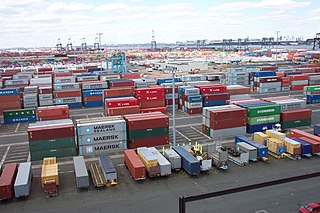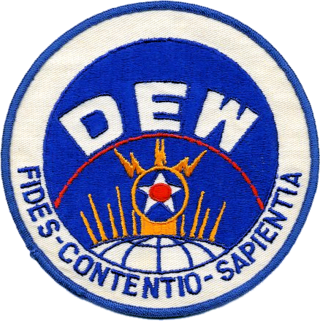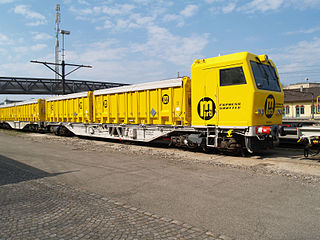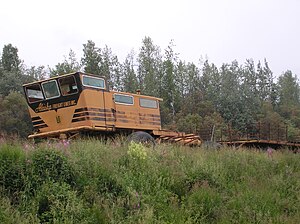
A locomotive is a rail transport vehicle that provides the motive power for a train. If a locomotive is capable of carrying a payload, it is usually rather referred to as a multiple unit, motor coach, railcar or power car; the use of these self-propelled vehicles is increasingly common for passenger trains, but rare for freight trains.

Rail transport is a means of transport using wheeled vehicles running in tracks, which usually consist of two parallel steel rails. Rail transport is one of the two primary means of land transport, next to road transport. It is used for about 8% of passenger and freight transport globally, thanks to its energy efficiency and potentially high speed.

Containerization is a system of intermodal freight transport using intermodal containers. Containerization, also referred as container stuffing or container loading, is the process of unitization of cargoes in exports. Containerization is the predominant form of unitization of export cargoes today, as opposed to other systems such as the barge system or palletization. The containers have standardized dimensions. They can be loaded and unloaded, stacked, transported efficiently over long distances, and transferred from one mode of transport to another—container ships, rail transport flatcars, and semi-trailer trucks—without being opened. The handling system is mechanized so that all handling is done with cranes and special forklift trucks. All containers are numbered and tracked using computerized systems.

VR-Group Plc, commonly known as VR, is a government-owned railway company in Finland. VR's most important function is the operation of Finland's passenger rail services with 250 long-distance and 800 commuter rail services every day. With 7,500 employees and net sales of €1,251 million in 2017, VR is one of the most significant operators in the Finnish public transport market area.

The Bristol Type 170 Freighter is a British twin-engine aircraft designed and built by the Bristol Aeroplane Company as both a freighter and airliner. Its best known use was as an air ferry to carry cars and their passengers over relatively short distances. A passenger-only version was also produced, known as the Wayfarer.

The White Pass and Yukon Route is a Canadian and U.S. Class III 3 ft narrow-gauge railroad linking the port of Skagway, Alaska, with Whitehorse, the capital of Yukon. An isolated system, it has no direct connection to any other railroad. Equipment, freight and passengers are ferried by ship through the Port of Skagway, and via road through a few of the stops along its route.

The Davenport Locomotive Works, of Davenport, Iowa, USA, was formed as the W W Whitehead Company in 1901. In 1902, the company commenced building light locomotives. The Company was renamed the Davenport Locomotive Works in 1904.

DB Cargo UK is a British rail freight company owned by Deutsche Bahn and headquartered in Doncaster, England.

The Distant Early Warning Line, also known as the DEW Line or Early Warning Line, was a system of radar stations in the northern Arctic region of Canada, with additional stations along the north coast and Aleutian Islands of Alaska, in addition to the Faroe Islands, Greenland, and Iceland. It was set up to detect incoming bombers of the Soviet Union during the Cold War, and provide early warning of any sea-and-land invasion.

In the 1950s, LeTourneau Inc. developed several overland trains, essentially oversized semi-trailer trucks that could travel over almost any terrain. Their intention was to be able to handle logistics needs without being dependent on local road or rail systems, allowing them to operate in back-country areas. The US Army had three experimental units built, the largest reaching almost 600 feet (183 m) long, which holds the record for the longest off-road vehicle. Road trains are in use in certain roles today, but the US Army examples and a few derivatives appear to be the only off-road examples built.

Rail freight transport is the use of railways and trains to transport cargo as opposed to human passengers.

The CargoSprinter is a freight multiple unit designed to transport freight or equipment. The CargoSprinter was designed by Windhoff GmbH (Germany) in the mid-1990s.

The SNCF BB 16500s were a class of SNCF electric locomotives operating at a supply voltage of 25 kV single-phase 50 Hz AC.

The Ofoten Line is a 43-kilometre (27 mi) railway line in Narvik Municipality, Norway. It runs from the Port of Narvik to Riksgränsen on the Norway–Sweden border, where the line continues as the Ore Line via Kiruna and Gällivare to Luleå. The Ofoten Line is single track, electrified at 15 kV 16.7 Hz AC and has seven stations. The line only connects to the rest of the Norwegian railway network via Sweden. The main traffic is up to 12 daily freight trains operated by Malmtrafik that haul iron ore from Sweden to Narvik. In addition, CargoNet operates container trains, branded as the Arctic Rail Express (ARE), and Vy Tåg operates passenger trains, including a night train to Stockholm.

The M62 is a Soviet-built diesel locomotive for heavy freight trains, exported to many Eastern Bloc countries as well as to Cuba, North Korea and Mongolia. Beside the single locomotive M62 also twin versions 2M62 and three-section versions 3M62 have been built. A total number of 7,164 single sections have been produced, which have been used to build 5,231 single-, twin- and three-section locomotives.

EU06 is a class of electric locomotives in service with the Polish state railway PKP.

The Iron Ore Line is a 398-kilometre (247 mi) long railway line between Riksgränsen and Boden in Norrbotten County, Sweden, owned by Trafikverket. The line also contains two branches, from Kiruna to Svappavaara and from Gällivare to Koskullskulle. The term is often colloquially used to also include the Ofoten Line, from Riksgränsen to Narvik in Norway, and the northernmost part of the Main Line Through Upper Norrland from Boden to Luleå. The railway from Narvik to Luleå is 473 kilometres (294 mi) long.

The M520 "Truck, Cargo, 8-ton, 4x4", nicknamed Goer, truck series was formerly the US Army’s standard heavy tactical truck before its replacement by the Oshkosh HEMTT. As trucks go, the Caterpillar-made Goer stands out due to being articulated, much wider than other trucks, and lacking suspension on the wheels.
LeTourneau Technologies, Inc. was an American manufacturer of heavy construction equipment founded by R. G. LeTourneau. In 2011, the company was acquired by Joy Global.

The Hercules DFXE was an American diesel truck engine produced by the Hercules Engine Company.



















